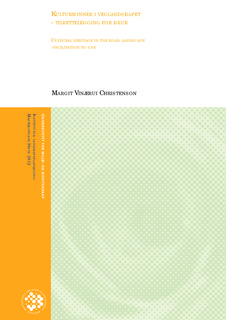| dc.description.abstract | Fysisk aktivitet i kombinasjon med natur-og kulturopplevelser blir stadig mer populært. Bruk av historiske veger, og dermed kulturminner i veglandskapet, har blitt mer og mer aktuelt, både som turisttilbud og som tn bidrag til stedsutvikling. Tendensen er at kulturminner skal være ressurser som fremmer lokalsamfunn og næringsliv, men på samme tid skal de vernes fordi de representerer verdier for de som kommer etter oss. Bruk og vern. Er dette motsetninger eller er de mulig å kombinere? Ved eventuell tilrettelegging må det nøye vurderinger til før det blir gjennomført, siden valgene som blir tatt vil påvirke opplevelsen av både kulturminnet og landskapet. Det er viktig å se på helheten, noe som gjør det til en naturlig og relevant oppgave for landskapsarkitekter.
Teorikapittelet inneholder redegjørelse om grunnleggende teorier ved restaurering, aktuelt lovverk som gjelder for kulturminner, historisk utvikling og dagens aktuelle prinsipper ved tilrettelegging. Kapittelet danner et nødvendig grunnlag for oppgaven videre.
Videre blir det foretatt en studie av eksempler på historiske veger med kulturminner i vegmiljøet som har blitt tilrettelagt eller oppgradert. Disse eksemplene gir verdifull informasjon om hvordan ulik tilrettelegging, gjennom istandsetting og formidling, gir forskjellig opplevelse av både historie og landskap. Eksempelstudiene munner ut i et studie av innfallsporter som en måte å ta opp med mål for å forbedre tilgjengeligheten til kulturminner. En innfallsport kan være identitetsskapende og gjøre inngangen til den historiske vegen tydeligere. Den kan utformes som et formidlingsområde og et sted som samler lokale aktører. I tillegg bidrar et slikt område til at selve kulturminnet skånes ved at tilretteleggingen legges i utkanten av kulturminnet.
Hovedtemaene som påvirker den historiske opplevelsen og landskapet, vegdekke og formidling i tillegg til innfallsport, blir undersøkt videre i et casestudie. Ved Kongevegen over Filefjell blir ulike løsningsforlag vedrørende disse temaene presentert, på bakgrunn av en analyse av caseområdet. Alternativene er tatt med for å kunne være et utgangspunkt for diskusjon. Fordeler og ulemper med de ulike forslagene vurderes i kapittel 5 Drøfting.
Målet er at noen av diskusjonene i casestudiet skal kunne overføres til lignende situasjoner. Casestudiet og alternativene er spesifikke, men diskusjonene kan brukes som utgangspunkt for lokale løsninger andre steder. Abstract: Physical activity combined with nature and cultural experiences is becoming more popular these days. The use of historical roads and the cultural heritage in their proximity has become
more and more applicable, both as a tourist offer, and as a contribution to local development. The tendency is that elements of cultural heritage should be a resource to promote community and business, at the same time they should be protected. The reasoning behind this line of thought is that the heritage in question, and the value it represents, must be preserved also for coming generations. To use, and to preserve. Is this a contradiction, or are the two possible to combine? Any facilitation must undergo rigorous and careful consideration before anything is decided. The choices made will affect the experience of both the monument and the landscape. One must look at the big picture. This makes it a natural and relevant task for landscape architects.
(a)An account of the basic theories of restoration, (b) relevant and applicable laws, (c) historical development, and finally (d) current relevant principles of facilitation of cultural heritage, form a necessary foundation for analysis in the theory chapter.
Chapter 3 describes the selected cases of historical cultural heritage in form of road landscapes, that have been facilitated or upgraded. These examples provide valuable information about different ways to facilitate. The example studies culminate in a study of gateways as a tool to realize ambitions of improving the accessibility of a cultural heritage site. A gateway can be facilitated to give the area a stronger identity, and make the entrance to the historic road more visible. It can be designed as a presentation area, and a place that brings together local actors. In addition, such an area will concentrate the facilitation where it lies, and thus preserve the actual site of cultural heritage better.
The main issues that affect the historical experience and the landscape, such as road surfaces and dissemination, in addition to the gateway, is examined further in the case studies. The Kings road over Filefjell is analysed, and different alternatives within the main issues are thereafter presented. Alternatives are included to provide a basis for discussion through describing advantages and disadvantages of the various proposals considered in Chapter 5.
The goal is that the lessons of the selected case studies will be transferable to similar situations. Case studies and alternative solutions are specific, but the discussions and analysis can hopefully be used as the basis for local solutions elsewhere. | no_NO |
